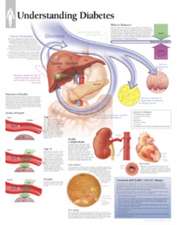The Neurohypophysis: Physiological and Clinical Aspects
Editat de Seymour Reichlinen Limba Engleză Paperback – 25 mar 2012
Preț: 365.61 lei
Preț vechi: 384.86 lei
-5% Nou
Puncte Express: 548
Preț estimativ în valută:
69.97€ • 72.78$ • 57.76£
69.97€ • 72.78$ • 57.76£
Carte tipărită la comandă
Livrare economică 14-28 aprilie
Preluare comenzi: 021 569.72.76
Specificații
ISBN-13: 9781468447385
ISBN-10: 1468447386
Pagini: 248
Ilustrații: XV, 224 p. 42 illus., 8 illus. in color.
Dimensiuni: 152 x 229 x 13 mm
Greutate: 0.34 kg
Ediția:Softcover reprint of the original 1st ed. 1984
Editura: Springer Us
Colecția Springer
Locul publicării:New York, NY, United States
ISBN-10: 1468447386
Pagini: 248
Ilustrații: XV, 224 p. 42 illus., 8 illus. in color.
Dimensiuni: 152 x 229 x 13 mm
Greutate: 0.34 kg
Ediția:Softcover reprint of the original 1st ed. 1984
Editura: Springer Us
Colecția Springer
Locul publicării:New York, NY, United States
Public țintă
ResearchDescriere
The elucidation of the structure, function, and clinical significance of the neurohypophysis has been one of the most rewarding chapters in the history of endocrinology. Diabetes insipidus, which can be manifested by passage of 15 liters of urine a day, is one of the most dramatic disorders of the endocrine system, and can readily be managed by replacement therapy with the natural secretions of this gland, or with synthetic analogues that provide a more favorable therapeutic ratio. The neurohypophysis is the archetypical neurosecretory gland. Its secretions arise within well defined nerve cells in the hypothalamus, are transported by axoplasmic flow to nerve endings in the neural lobe, are released in response to propagated action potentials, and are regulated by neurotransmitters and osmotic signals. This gland is a model for homeostatic regulation; functional disorders of this regulation lead to well defined disorders such as the syndrome of inappropriate secretion of antidi uretic hormone (SIADH), which can be mimicked by the ectopic secretion of its hormones by tumor cells. These hormones were the first peptides to be sequenced and synthesized chemically and their structure-function relations have been characterized as well as those of any of the peptide hormones. The concept that peptide hormones generally arise as products of the processing of a larger prohormone precursor was first developed from studies of the neurohypophysis. The concept of stimulus-secretion coupling was first ap plied in neuronal tissue to the neurohypophysis.
Cuprins
1 The Neurohypophysis: Historical Overview.- 2 Anatomy of Pituitary and Extrapituitary Vasopressin Secretory Systems.- 1. Introduction.- 1.1. Historical Overview.- 1.2. Studies with Gomori Stains.- 1.3. Biochemistry and Autoradiography.- 1.4. Immunocytochemical Approaches.- 2. Magnocellular Vasopressin and Oxytocin Systems.- 2.1. Cells Contributing to the Neurohypophysial Pathway.- 2.2. Distribution of Neurons in the Nuclei.- 2.3. Course of the Pathway.- 2.4. Other Peptides in the System.- 3. Parvocellular Vasopressin Secretory System to Median Eminence.- 3.1. History of Vasopressin Secretion into Portal Blood.- 3.2. New Evidence for a Vasopressin Pathway to Median Eminence.- 3.3. Continuing Controversies.- 3.4. Effects of Glucocorticoids.- 4. Parvocellular Systems.- 4.1. Vasopressin in the Suprachiasmatic Nucleus.- 4.2. Extrahypothalmic Systems.- 4.3. Cells of Origin and Trajectory.- 5. Functional Roles of Vasopressin Pathways.- 5.1. Forebrain Functions.- 5.2. Autonomic Control.- 5.3. Coordination of Stress Responses.- 6. Addendum.- References.- 3 Biosynthesis of Vasopressin and Neurophysin.- 1. Introduction.- 2. Identification of the Vasopressin Precursor.- 2.1. Studies on Intact Systems (in Vivo).- 2.2. Cell-Free Translation Studies.- 2.3. Recombinant DNA Studies.- 2.4. Other Precursors for Vasopressin.- 3. Posttranslational Processing of the Arginine Vasopressin-Neurophysin Precursor.- 4. Future Considerations.- References.- 4 The Mode of Action of Antidiuretic Hormone: Membrane Reorganization, Recycling, and Intracellular Transport.- 1. Historical Background.- 2. The Toad Urinary Bladder as a Model System.- 3. The Biochemical Mode of Antidiuretic Hormone Action.- 4. The Permeability of the Luminal Membrane.- 5. Basis for Sustained Water Movement.- 6. Prospective.- References.- 5 The Contribution of Measured Secretion of Neurophysins to Our Understanding of Neurohypophysial Function.- 1. Background.- 2. Classification of Neurophysins.- 2.1. Bovine Hormone-Specific Neurophysins.- 2.2. Porcine Hormone-Specific Neurophysins.- 2.3. Rat Hormone-Specific Neurophysins.- 2.4. Human Hormone-Specific Neurophysins.- 2.5. Stimulus-Specific Release of Individual Neurophysins.- 2.6. Conclusions Regarding Classification of Neurophysins.- 3. Neurophysin Pathways and Sites of Secretion.- 3.1. Physiologic Secretion from the Posterior Pituitary.- 3.2. Pathologic Secretion of Vasopressin.- 3.3. Secretion at the Median Eminence.- 3.4. Secretion into Cerebrospinal Fluid.- References.- 6 Pathology of the Neurohypophysis.- 1. Anatomy and Histology.- 2. Pathology.- 3. Summary.- References.- 7 Clinical and Laboratory Features of Central and Nephrogenic Diabetes Insipidus and Primary Polydipsia.- 1. Clinical Features.- 2. Laboratory Features.- 3. Summary.- References.- 8 Management of Neurogenic Diabetes Insipidus with dDAVP and Other Agents.- 1. General Considerations in Treatment.- 2. Drugs Used to Treat Neurogenic Diabetes Insipidus.- 2.1. Conventional Neurohypophysial Preparations.- 2.2. dDAVP.- 2.3. Nonhormonal Agents.- 3. Management of Acute Neurogenic Diabetes Insipidus.- 3.1. Pathogenesis.- 3.2. Evaluation and Treatment.- References.- 9 Syndrome of Inappropriate Antidiuretic Hormone Secretion.- 1. Introduction.- 2. The Clinical Problems in Patients with SIADH.- 3. Causes of SIADH.- 3.1. Cancer.- 3.2. Neurohypophysial Trauma.- 3.3. Neurologic Disease.- 3.4. Postoperative SIADH.- 3.5. SIADH Associated with Pulmonary Disease.- 3.6. SIADH Associated with Endocrine Disorders.- 3.7. Psychiatric Disorders.- 3.8. Idiopathic SIADH.- 3.9. Drug-Induced SIADH.- 4. Differential Diagnosis.- 5. Treatment.- 5.1. Acute Treatment.- 5.2. Long-Term Treatment.- 6. Summary.- References.- 10 Treatment of Sickle Cell Anemia with dDAVP.- 1. Introduction.- 2. Results.- 2.1. Effect of Chronic Hyponatremia on Mean Corpuscular Hemoglobin Concentration.- 2.2. Effect of Hyponatremia on Percentage of Sickle Cells at Varying Oxygen Tensions of Blood.- 2.3. Effect on Oxygen Affinity of Hemoglobin S.- 2.4. Effect of Hyponatremia on Prevention of Sickle Cell Crises.- 2.5. Dilutional Hyponatremia in the Treatment of Acute Sickle Cell Crisis.- 2.6. Effect of Hyponatremia on Red Blood Cell Survival.- 3. Discussion.- 4. Summary.- References.- 11 dDAVP in von Willebrand’s Disease and in Moderately Severe Hemophilia A.- 1. Introduction.- 2. Historical Aspects.- 3. dDAVP: Mechanism of Action.- 4. Clinical Trials and Observations with dDAVP in Europe.- 4.1. Effect of dDAVP on Bleeding Time.- 4.2. Clinicopharmacologic Studies.- 5. United States Experience with dDAVP.- 5.1. Materials and Methods.- 5.2. Observations and Results.- 6. Discussion.- 6.1. Intranasal versus Intravenous Administration.- 6.2. Clinical Use.- 6.3. Use of çiDAVP for Menorrhagia.- 6.4. Selection of Subjects.- 7. Summary.- 8. Addendum.- References.








